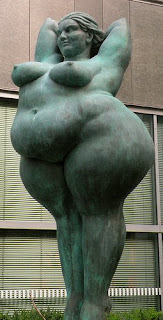By Sheila Moeschen
When the brash, outspoken, robust comedienne Roseanne Bar announced her presence on the comedy circuit in the late-1980s, people thought it had to be an act. C’mon, no one sounds that bitchy, bored and contemptuous all the time, right? And while we’re on the subject, that Apple company is never really going to make a comeback, is it? People thought differently after the night of July 25, 1990. In the span of 1 minute and 16 seconds, a frequency and tone shattered the lush San Diego night that made dogs run into traffic and unborn babies stick their fingers in their ears.
That night Roseanne performed her very special rendition of the Star Spangled Banner before a San Diego Padres baseball game. Hocking a wet lugie on the dusty mound for good measure, the edgy comic flashed her toothy smile and grabbed her crotch before ambling off the field, jogging slightly to avoid the hailstorm of beer cups and obscenities hurled down upon her.
That night Roseanne performed her very special rendition of the Star Spangled Banner before a San Diego Padres baseball game. Hocking a wet lugie on the dusty mound for good measure, the edgy comic flashed her toothy smile and grabbed her crotch before ambling off the field, jogging slightly to avoid the hailstorm of beer cups and obscenities hurled down upon her.
The funny fat lady had sung, but it definitely was far from over. During her stand-up career in the 1980s and early 1990s, Roseanne honed her stage persona based largely on her average looks, blue collar observations about white collar life, nasally piercing voice, and full figure. She owned her girth with jokes like: “Fat moms are way better than skinny moms. What do you want when you’re depressed? A skinny mom goes ‘Well, why don’t you jog around the block and release the adrenaline from your body.’ A fat mom says ‘Let’s have some Oreos and pudding. When you wake up from that sugar coma it will be a brand new week.’” Part trailer trash, part working-class Jane, and part satirical “Domestic Goddess,” Roseanne’s self-effacing style and open disdain for, well, everything was indebted to a long tradition of comediennes working in one of the theatre’s most grueling, unforgiving and cutting-edge mediums: vaudeville.
During the turn of the century, vaudeville featured fast-paced, raw, bawdy, highly physical, manic entertainment. Jugglers, singers, dancers, and comics shared the nightly bill with animal acts and novelty performances. Entertainers created new material weekly and sometimes nightly, kind of like a daily, living Rocky movie if Rocky had been a writer/performer, with twice the sweat and three times the stakes, but with a less kick-ass soundtrack.
Vaudeville was cheap and highly visual so it appealed to working class audiences and non-native spectators (a wife and sheep bit plays the same in any culture). It was also an ideal forum for female performers who didn’t conform to the standards of beauty, figure and (my personal favorite) “pleasantness” put forth by society’s standards for the actress working the “legitimate” (i.e. non-musical, non-variety) theatre. In her book Rank Ladies, Theatre historian Alison Kibler describes the world of vaudeville and its funny women:
“The eccentric women in vaudeville … were fat, dark-skinned or ‘too mannish.’ In the playful, often novel world of vaudeville, the grotesque women who joked and cackled at prudish Victorian matrons, abused husbands in comic sketches, and took over male parts in athletic acts and slapstick routines were regularly labeled freaks, transvestites and deviants.”
They also did a lot of suggestive winking and nudging, which was the Roseanne-crotch-grab equivalent. And most importantly, they were hugely popular (pun intended, wink-wink, nudge-nudge).
Women such as Marie Dressler, Trixie Friganza and Eva Tanguay, self-proclaimed, fat and funny comediennes, won popular and critical acclaim during their careers in the early-1900s.
Marie Dressler as the dowager in "Dinner at Eight."
Dressler, weighing more than 200 pounds, capitalized off her mannish features and outrageous physique by using physical comedy to heighten the disparity between herself and her slender and attractive cast mates. One description of a 1914 performance noted the hilarity that ensued when Dressler sat on and crushed her fellow slender, male player (said crushed player could not be reached for comment. Nudge-nudge, pun-pun).
Similarly, Friganza, one of the earliest predecessors of contemporary stand-up comediennes, created her acts around “fat girl troubles,” or issues of attractiveness and marriage. Audiences celebrated these women who bore everything thing they had (and even things they manufactured) for comedy’s sake. Their presence in vaudeville and their popularity helped other women to make a deeper impact on the male-dominated industry. Moreover, by playing on their physicality, these women presented a wry, humorous critique of cultural gender norms. But to what ends?
Turns out, people became a bit angry at Roseanne Barr, claiming she went too far in her parody of ball players and America’s pastime. The ugly backlash against the comic hit her square in the gut (nudge-nudge, literally). Roseanne became the poster child for the shrewish, unruly, unattractive, loud-mouthed woman, which, ipso facto translated into: undesirable. Dressler and her cohort faced a similar issue in their comic approach: By using their unconventional bodies as comic fodder they risked perpetuating the worst types of stereotypes and perceptions of women. Dressler’s legacy resides in Roseanne, Lisa Lampanelli, Mo’Nique, and many others who place themselves as the object of derision, but is there a political, artistic, and personal limit to this approach?
Who laughs last, the funny fat lady or the lady who thinks fat is funny?
...
Woman in comedy Sheila Moeschen has a PhD in Theatre & Drama from Northwestern University with a Minor in Gender Studies. She puts theory into practice as an improv and sketch comedienne in Boston, MA.










.jpeg)
No comments
Post a Comment